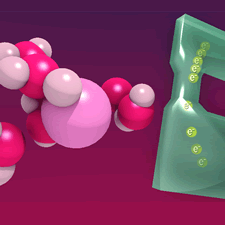Successful Measurement of Ion Concentrations in Serum Using Nanoscale Silicon Transistor
- Advancing toward realizing sophisticated sensors that exploit new surface chemistry -

Nippon Telegraph and Telephone Corporation (hereinafter NTT), in collaboration with the French National Center for Scientific Research (Centre national de la recherche scientifique CNRS), and Delft University of Technology (TU Delft), has discovered that the a variety of cations in aqueous solution in contact with the surface of a nanoscale silicon transistor change the current flowing through the transistor. By utilizing this phenomenon, the researchers have succeeded in measuring cation concentrations in blood serum.
Transistor-based ion sensors usually require the addition of ion selective layers to distinguish and detect specific ions, resulting in complex structures and systems. The research team confirmed that by exploiting ion response unique to nanoscale surface, a variety of ions can be measured without requiring the use of ion selective layers. This achievement is expected to lead to the development of sophisticated sensors that exploit new surface chemistry.
The findings was published in the online edition of the British journal Nature Materials on February 5, 2018 (UK time).
=> Press Release
=> Nanodevices Research Group
Background of the research
Research of microchemical sensors is being widely pursued due to their use in the chemical industry and possible application in the development of portable medical instruments. Conventional chemical sensors achieve ion sensitivity by using ion selective layers*1 to selectively distinguish target ions to be measured. This necessitates the need to prepare measurement cartridges for each type of ion. ISFET*2, which are transistor-based ion sensors, were proposed around 1970 as a type of microdevice for measuring electrochemical signals with transistors. At present, they are also being used as pH (hydrogen ion concentration) sensors. However, because the structure of an ISFET device becomes complex when ion selective layers are added for each type of ion, challenges to their use include the need to stably immobilize ion selective layers and extend the layers’ lifespan.
NTT has been advancing the development of ultrafine scale devices with outstanding reproducibility and stability, such as nanotransistors and single-electron devices manufactured with silicon technology. Testing has confirmed that NTT’s nanotransistors can operate stably as high-sensitivity electrical charge sensors capable of detecting a single electron at room temperature.
Research results
In collaboration with CNRS and TU Delft, NTT has succeeded in measuring various cation concentrations in serum with a single device by using nano-ISFET (Figure 1). For this device, a microfluidic channel*3 is fabricated on the silicon nanotransistor. This means there is no need to use ion selective layers.
First, to confirm the basic behavior of the nano-ISFET, response to ion concentration in solutions was measured. Besides hydrogen ions, the results showed high sensitivity to a variety of cations such as Li+, Na+, K+, Ca2+, and Mg2+ (Figure 2). Furthermore, in a complex solution of multiple cations, the research team discovered that each concentration’s response signal contributed additively to the output, so each cation concentration could be independently measured. By utilizing the response to the cations, the team succeeded in using the same nano-ISFET to measure the concentrations of various cations in serum without the need to use ion selective layers.(Figure 3)
The surface of the silicon is covered by silicon oxide film, a gate insulator. Its response to a variety of cations is completely different from previous findings, and is believed to be a phenomenon unique to nanoscale silicon surface. At present, the reason for this phenomenon has not yet been elucidated. However, molecular dynamics simulation (Figure 4, TU Delft) suggests the importance of water molecule-intervening non-Coulomb interactions*4, which take place instead of conventional interactions between ions and the surface. The results suggest the possibility of a new class of sophisticated sensors that exploit new surface chemistry.
Technological point
In order for ISFET to operate stably, technology to manufacture transistors with outstanding reproducibility and low noise is required. The combination of NTT’s nanotransistor manufacturing technology and the microfluidic channel fabrication technology developed by CNRS makes possible the manufacture of ISFET with stable sensitivity at the single electron level, even in solution. The newly developed method of measuring cation response and ion concentration in serum was made possible by the stable operation of NTT’s nanosilicon ISFET.
Future prospects
The success of using nanoscale transistors to detect specific ion response and measure a variety of ions without ion selective layers will expand the possibility of developing sophisticated sensors that exploit new surface chemistry. Going forward, NTT researchers will continue to elucidate details about the mechanism of ion response on the nanotransistor’s surface, improve measurement accuracy, and develop advanced sensors.
Publication details
R. Sivakumarasamy, R. Hartkamp, B. Siboulet, J.-F. Dufreche, K. Nishiguchi, A. Fujiwara, and N. Clément,
“Selective layer free Blood Serum Ionogram based on Ion-specific Interactions with a Nanotransistor”,
Nature Materials (2018).
Glossary
*1 ... ion selective layer
Film material that responds selectively to specific ions. Other terms include ion-sensitive film, etc.
*2 ... ISFET
Stands for Ion-Sensitive Field-Effect Transistor. A sensor that measures the concentration of ions in solution by detecting change in electric potential occurring at the surface of the field-effect transistor’s gate insulator from change in the transistor’s electrical current.
*3 ... Microfluidic channel
Fluidic channel formed by using microfabrication technology. Microfluidic channels are used in lab-on-a-chip, which performs chemical analysis on a single integrated circuit (chip). The microfluidic channels on top of NTT’s nanotransistor presented in this press release are fabricated from polydimethylsiloxane (PDMS), a silicon-based polymer.
*4 ... non-Coulomb interaction
Of the interactions at work between ions and between molecules, refers to electric polarization interactions and exchange interactions of electrons (quantum mechanical interactions that arrange the spin direction of two or more electrons in the parallel or antiparallel direction). Also generically called the van der Waals force.










